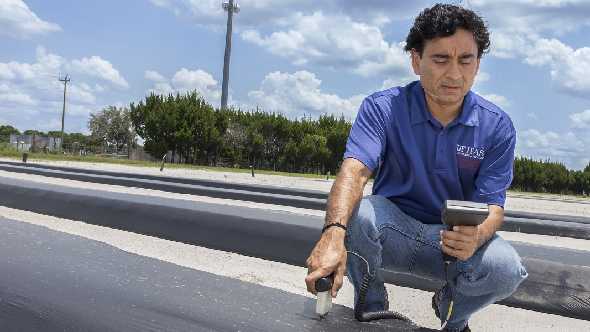Geometrically Speaking, Thinking Smaller Might Produce Big Savings For Vegetable Growers
For some time, University of Florida professor Sanjay Shukla has wondered what would happen if he made the compacted soil rows for his tomato and pepper crops taller and more narrow. Curious about water, fertilizer, and fumigation needs, as well as growth and yield, the research results that followed helped the agricultural and biological engineering specialist get a pretty good idea.

Photo courtesy of UF/IFAS
Instead of planting rows that were normally 6 to 8 inches high and about 3 feet across, Shukla planted them 10 inches to a foot high and 1½ to 2 feet across. Instead of needing two drip lines to irrigate each row, they required only one. In addition, they needed fewer square feet in plastic mulch covering. He calls it “compact bed geometry” or “hilling.”
According to Shukla, who is based at the UF/IFAS Southwest Florida Research and Education Center in Immokalee, not only did the tall narrow rows grow the same amount of vegetables, they retained more fertilizers – reducing what would have leached into groundwater – and they would need half the amount of water. In addition, he cut fumigation rates for pests by as much as 50%.
He estimates the revamped rows could save farmers $100 to $300 an acre, depending on the crop, the setup of their farm and how many drip lines they use per row; with a 1,000-acre farm, that can add up to a $300,000 savings. If used statewide, the potential cost savings for vegetable growers who use plastic mulch, could run into millions per crop per year.
Several farms have already adopted Shukla’s tall, narrow rows, including a 2,000-acre tomato operation. Chuck Obern, who grows eggplants and peppers at C&B Farms in Clewiston, has switched 140 acres of eggplants and estimates he has saved at least $500 an acre on the cost of drip tape for irrigation, fumigation, and the pumping of water and fertilizer.
“His experiment was in a production field and they were side by side with our crops,” Obern said. “His experiment used half the water and half the fertilizer as our crop, yet you couldn’t see any difference. It told us we were wasting half our water and fertilizer.”
Obern said he is excited to see what Shukla can do for his pepper crop in the fall.
Shukla says his next step is to explore if the compact bed geometry will work elsewhere. If it does, it has the potential to help improve agriculture globally.
“I’m hoping to go to California and Georgia to learn about their production systems and see what can be done at a larger scale,” he said.









